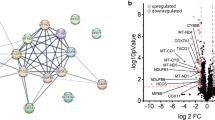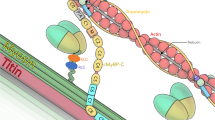Abstract
Myotonic dystrophy type 1 (DM1) and myotonic dystrophy type 2 (proximal muscular myopaty/DM2) are caused by similar dynamic mutations at two distinct genetic loci. The two diseases also lead to similar phenotypes but different clinical severity. Dysregulation of alternative splicing has been suggested as the common pathogenic mechanism. Here, we investigate the molecular differences between DM1 and DM2 using reverse transcriptase-polymerase chain reaction of troponin T (TnT) and the insulin receptor (IR), as well as immunoblotting of TnT in muscle biopsies from DM1 and DM2 patients. We found that: (a) slow TnT was encoded by two different transcripts in significantly different ratios in DM1 and DM2 muscles; (b) DM2 muscles exhibited a higher degree of alternative splicing dysregulation for fast TnT transcripts when compared to DM1 muscles; (c) the distribution of TnT proteins was significantly skewed towards higher molecular weight species in both diseases; (d) the RNA for the insulin-independent IR-A isoform was significantly increased and appeared related to the fibre-type composition in the majority of the cases examined. On the whole, these data should give a better insight on pathogenesis of DM1 and DM2.



Similar content being viewed by others
References
Harper PS (2001) Myotonic dystrophy, 3rd edn. WB Saunders, London
Vihola A, Bassez G, Meola G, Zhang S, Haapasalo H, Paetau A, Mancinelli E, Rouche A, Hogrel JY, Laforet P, Maisonobe T, Pellissier JF, Krahe R, Eymard B, Udd B (2003) Histopathological differences of myotonic dystrophy type 1 (DM1) and PROMM/DM2. Neurology 60:1854–1857
Jansen G, Mahadevan M, Amemiya C, Wormskamp N, Segers B, Hendriks W, O’hoy K, Baird S, Sabourin L, Lennon G, Jap PL, Iles D, Coerwinkel M, Hofker M, Carrano AV, De Jong PJ, Korneluk RG, Wieringa B (1992) Characterization of the myotonic dystrophy region predicts multiple protein isoform-encoding mRNAs. Nat Genet 1:261–266
Groenen PJTA, Wansink DG, Coerwinkel M, Van Den Broek W, Jansen G, Wieringa B (2000) Constitutive and regulated modes of splicing produce six major myotonic dystrophy protein kinase (DMPK) isoforms with distinct properties. Hum Mol Genet 9:605–616
Wansink DG, Van Herpen REMA, Coerwinkel-Driessen MM, Groenen PJTA, Hemmings BA, Wieringa B (2003) Alternative splicing controls myotonic dystrophy protein kinase structure, enzymatic activity, and subcellular localization. Mol Cell Biol 23:5489–5501
Taneja KL, Mccurrach M, Schalling M, Housman D, Singer RH (1995) Foci of trinucleotide repeat transcripts in nuclei of myotonic dystrophy cells and tissues. J Cell Biol 128:995–1002
Davis BM, McCurrach ME, Taneja KL, Singer RH, Housman DE (1997) Expansion of a CUG trinucleotide repeat in the 3′ untranslated region of myotonic dystrophy protein kinase transcripts results in nuclear retention of transcripts. Proc Natl Acad Sci USA 94:7388–7393
Ladd AN, Charlet-BN Cooper TA (2001) The CELF family of RNA binding proteins is implicated in cell-specific and developmentally regulated alternative splicing. Mol Cell Biol 21:1285–1296
Miller JW, Urbinati CR, Teng-Umnuay P, Stenberg MG, Byrne BJ, Thornton CA, Swanson MS (2000) Recruitment of human muscleblind proteins to (CUG)n expansions associated with myotonic dystrophy. EMBO J 19:4439–4448
Philips AV, Timchenko LT, Cooper TA (1998) Disruption of splicing regulated by a CUG-binding protein in myotonic dystrophy. Science 280:737–741
Faustino NA, Cooper TA (2003) Pre-mRNA splicing and human disease. Genes Dev 17:419–437
Ricker K (1999) Myotonic dystrophy and proximal myotonic myopathy. J Neurol 246:334–338
Meola G (2000) Clinical and genetic heterogeneity in myotonic dystrophies. Muscle Nerve 23:1789–1799
Liquori CL, Ricker K, Moseley ML, Jacobsen JF, Kress W, Naylor SL, Day JW, Ranum LP (2001) Myotonic dystrophy type 2 caused by a CCTG expansion in intron 1of ZNF9. Science 293:864–867
Mankodi A, Urbinati CR, Yuan QP, Moxley RT, Sansone V, Krym M, Henderson D, Schalling M, Swanson MS, Thornton CA (2001) Muscleblind localizes to nuclear foci of aberrant RNA in myotonic dystrophy types 1 and 2. Hum Mol Genet 10:2165–2170
Fardaei M, Rogers MT, Thorpe HM, Larkin K, Hamshere MG, Harper PS, Brook JD (2002) Three proteins, MBNL, MBLL and MBXL, co-localize in vivo with nuclear foci of expanded-repeat transcripts in DM1 and DM2 cells. Hum Mol Genet 11:805–814
Saggin L, Gorza L, Ausoni S, Schiaffino S (1990) Cardiac troponin T in developing, regenerating and denervated rat skeletal muscle. Development 110:547–554
Salvatori S, Fanin M, Trevisan CP, Furlan S, Reddy S, Nagy JI, Angelini C (2005) Decreased expression of DMPK: correlation with CTG repeat expansion and fibre type composition in myotonic dystrophy type 1. Neurol Sci 26:235–242
Gahlmann R, Troutt AB, Wade RP, Gunning P, Kedes L (1987) Alternative splicing generates variants in important functional domains of human slow skeletal troponin T. J Biol Chem 262:16122–16126
Kanadia RN, Johnstone KA, Mankodi A, Lungu C, Thornton CA, Esson D, Timmers AM, Hauswirth WW, Swanson MS (2003) A muscleblind knockout model for myotonic dystrophy. Science 302:1978–1980
Savkur RS, Philips AV, Cooper TA (2001) Aberrant regulation of insulin receptor alternative splicing is associated with insulin resistance in myotonic dystrophy. Nat Genet 29:40–47
Bodor GS, Survant L, Voss EM, Smith S, Porterfield D, Apple FS (1997) Cardiac troponin T composition in normal and regenerating human skeletal muscle. Clin Chem 43:476–484
Hartner KT, Kirschbaum BJ, Pette D (1989) The multiplicity of troponin T isoforms. Distribution in normal rabbit muscles and effects of chronic stimulation. Eur J Biochem 179:31–38
Perry SV (1998) Troponin T: genetics, properties and function. J Muscle Res Cell Motil 19:575–602
Samson F, Mesnard L, Mihovilovic M, Potter TG, Mercadier JJ, Roses AD, Gilbert JR (1994) A new human slow skeletal troponin T (TnTs) mRNA isoform derived from alternative splicing of a single gene. Biochem Biophys Res Commun 199:841–847
Novelli G, Gennarelli M, Zelano G, Sangiuolo F, Lo Cicero S, Samson F, Dalla Piccola B (1992) Polymerase chain reaction in the detection of mRNA transcripts from the slow skeletal troponin T (TNNT1) gene in myotonic dystrophy and normal muscle. Cell Biochem Funct 10:251–256
Osborne RJ, Thornton CA (2006) RNA-dominant diseases. Hum Mol Genet 15(2):R162–R169
Savkur RS, Philips AV, Cooper TA, Dalton JC, Moseley ML, Ranum LPW, Day JW (2004) Insulin receptor splicing alteration in myotonic dystrophy type 2. Am J Hum Genet 74:1309–1313
Mankodi A, Takahashi MP, Jiang H, Beck CL, Bowers WJ, Moxley RT, Cannon SC, Thornton CA (2002) Expanded CUG repeats trigger aberrant splicing of ClC-1 chloride channel pre-mRNA and hyperexcitability of skeletal muscle in myotonic dystrophy. Mol Cell 10:35–44
Kimura T, Nakamori M, Lueck JD, Pouliquin P, Aoike F, Fujimura H, Dirksen RT, Takahashi MP, Dulhunty AF, Sakoda S (2005) Altered mRNA splicing of the skeletal muscle ryanodine receptor and sarcoplasmic/endoplasmic reticulum Ca2+-ATPase in myotonic dystrophy type 1. Hum Mol Genet 14:2189–2200
Morrone A, Pegoraro E, Angelini C, Zammarchi E, Marconi G, Hoffman EP (1997) RNA metabolism in myotonic dystrophy: patient muscle shows decreased insulin receptor RNA and protein consistent with abnormal insulin resistance. J Clin Invest 99:1691–1698
Perseghin G, Caumo A, Arcelloni C, Benedini S, Lanzi R, Pagliato E, Piceni Sereni L, Testolin G, Battezzati A, Comi G, Comola M, Luzi L (2003) Contribution of abnormal insulin secretion and insulin resistance to the pathogenesis of type 2 diabetes in myotonic dystrophy. Diabetes Care 26:2112–2118
Guiraud-Dogan C, Huguet A, Gomes-Pereira M, Brisson E, Bassez G, Junien C, Gourdon G (2007) DM1 CTG expansions affect insulin receptor isoforms expression in various tissues of transgenic mice. Biochim Biophys Acta 1772:1183–1191
Jin JP, Chen A, Huang QQ (1998) Three alternatively spliced mouse slow skeletal muscle troponin T isoforms: conserved primary structure and regulated expression during postnatal development. Gene 214:121–129
Barton PJ, Felkin LE, Koban MU, Cullen ME, Brand NJ, Dhoot GK (2004) The slow skeletal muscle troponin T gene is expressed in developing and diseased human heart. Mol Cell Biochem 263:91–97
Cullen ME, Dellow KA, Barton PJR (2004) Structure and regulation of human troponin genes. Mol Cell Biochem 263:81–90
Vullhorst D, Buonanno A (2003) Characterization of general transcription factor 3, a transcription factor involved in slow muscle-specific gene expression. J Biol Chem 278:8370–8379
Kim DH, Langlois MA, Lee KB, Riggs AD, Puymirat J, Rossi JJ (2005) HnRNP H inhibits nuclear export of mRNA containing expanded CUG repeats and a distal branch point sequence. Nucleic Acids Res 33:3866–3874
Ebralidze A, Wang Y, Petkova V, Ebralidse K, Junghans RP (2004) RNA leaching of transcription factors disrupts transcription in myotonic dystrophy. Science 303:383–387
Acknowledgments
This work was supported by grants from Telethon-Italy (GTB07001) and EuroBioBank to Corrado Angelini and from MIUR to Sergio Salvatori.
Author information
Authors and Affiliations
Corresponding author
Rights and permissions
About this article
Cite this article
Salvatori, S., Furlan, S., Fanin, M. et al. Comparative transcriptional and biochemical studies in muscle of myotonic dystrophies (DM1 and DM2). Neurol Sci 30, 185–192 (2009). https://doi.org/10.1007/s10072-009-0048-4
Received:
Accepted:
Published:
Issue Date:
DOI: https://doi.org/10.1007/s10072-009-0048-4




